How to Determine If Raccoons Can Eat Spicy Food
Raccoons are omnivorous and can detect capsaicin, the active component in spicy foods, through their taste receptors. Sensitivity to capsaicin varies and ingestion may lead to gastrointestinal issues like vomiting, diarrhea, and gastritis.
Chronic intake of spicy foods may disrupt nutrient absorption and damage the mucosal lining. Behavioral changes, such as increased agitation and altered foraging, have been observed.
Experts advise against feeding raccoons spicy foods, emphasizing a diet of fruits, vegetables, proteins, nuts, and seeds to maintain their health. For a comprehensive understanding of raccoons and their dietary needs, further information can provide more insights.
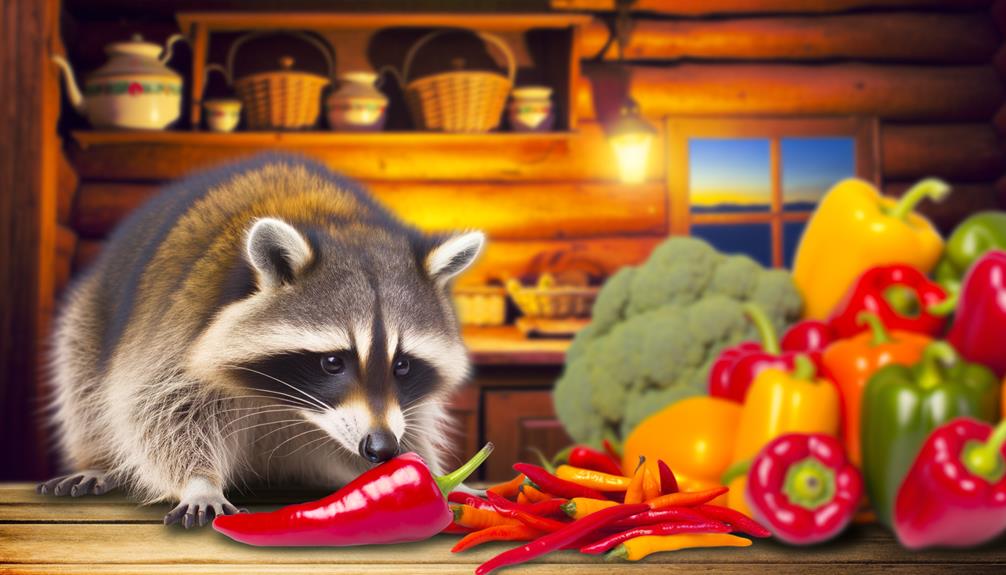
Key Takeaways
- Raccoons can eat spicy food but their taste receptors detect capsaicin, which can lead to gastrointestinal issues.
- Ingestion of spicy food may cause vomiting, diarrhea, and potential gastritis or ulcers in raccoons.
- Long-term consumption of spicy food can disrupt nutrient absorption and damage the mucosal lining in raccoons.
- Behavioral changes, such as increased agitation and altered foraging patterns, have been observed in raccoons after eating spicy food.
- Experts recommend a balanced diet of fruits, vegetables, proteins, nuts, and seeds for raccoons, avoiding spicy foods to prevent health risks.
Raccoons' Natural Diet
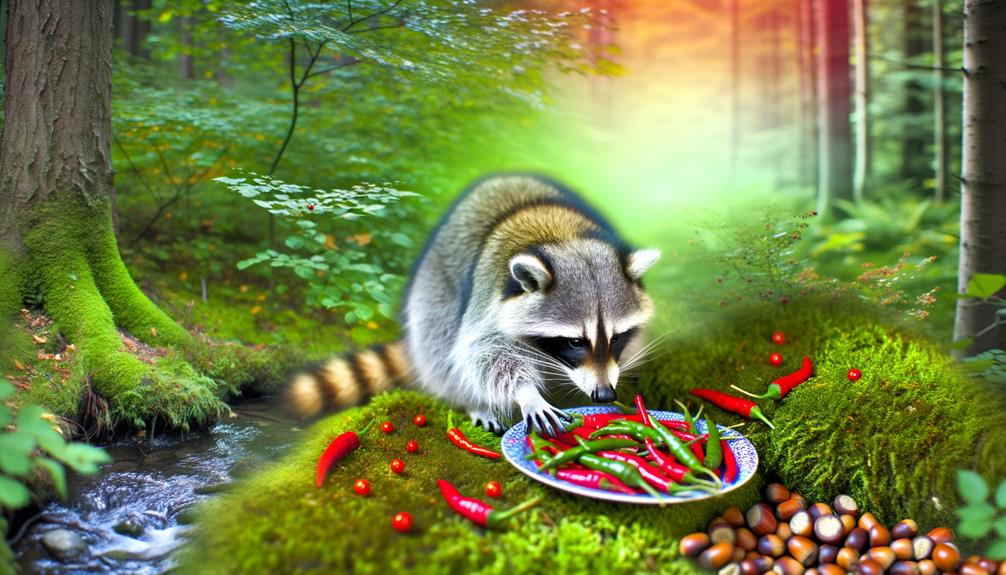
Raccoons (Procyon lotor) are omnivorous animals whose natural diet encompasses a diverse range of food sources, including fruits, nuts, insects, and small vertebrates. This dietary diversity is a reflection of their broad ecological niche and opportunistic feeding behavior, enabling them to adapt to various environments.
Studies have shown that raccoons exhibit a preference for high-energy foods, often consuming those that are seasonally abundant. For instance, in temperate regions, their diet shifts from mainly insects and small vertebrates in spring and summer to fruits and nuts in autumn. This adaptability is essential for their survival and reproductive success.
Additionally, raccoons possess tactile sensitivity in their forepaws, which aids in the detection and manipulation of various food items, optimizing their foraging efficiency.
Understanding Capsaicin
Capsaicin, the active component in chili peppers, is a lipophilic chemical compound known for its pungent characteristic.
It interacts with the transient receptor potential vanilloid 1 (TRPV1) receptor, which is responsible for the perception of heat and pain in mammals.
The sensitivity to capsaicin varies notably among species, influencing their ability to consume spicy foods without adverse effects.
Capsaicin's Chemical Structure
The molecular structure of capsaicin comprises a vanillyl group linked to an amide bond, which in turn is connected to an 8-methyl-6-nonenoyl chain. This configuration grants capsaicin its distinctive pungency and bioactive properties.
The vanillyl group, a derivative of vanillin, contributes to the molecule's affinity for sensory receptors. The amide bond serves as a stable linker, enabling efficient transmission of molecular effects. The 8-methyl-6-nonenoyl chain imparts hydrophobic characteristics, facilitating its interaction with lipid membranes.
Collectively, these elements enable capsaicin to bind selectively to the transient receptor potential vanilloid 1 (TRPV1) receptor, a critical mediator in sensory neurons.
Understanding this intricate structure is pivotal for elucidating capsaicin's mechanistic pathways and its broader physiological implications.
Effects on Mammals
Understanding the physiological effects of capsaicin on mammals requires an examination of its interaction with the TRPV1 receptor, which plays a key role in pain perception and thermoregulation.
Capsaicin binds to the TRPV1 receptor, a ligand-gated ion channel, causing an influx of calcium and sodium ions. This triggers depolarization of the neuronal membrane, leading to the sensation of burning pain. Additionally, capsaicin-induced activation of TRPV1 receptors can lead to the release of neuropeptides such as substance P, contributing to inflammation and hyperalgesia.
Regarding thermoregulation, capsaicin influences hypothalamic pathways, potentially affecting body temperature. These physiological responses are essential for understanding how capsaicin affects various mammalian species, including raccoons, and their ability to consume spicy foods.
Spicy Food Sensitivity
Investigating the sensitivity to spicy food in mammals requires a detailed understanding of capsaicin's interaction with sensory pathways and receptor mechanisms.
Capsaicin, the active component in chili peppers, binds to the transient receptor potential vanilloid 1 (TRPV1) receptors, which are mainly found on sensory neurons. Activation of TRPV1 receptors results in the perception of burning pain, a defensive mechanism to discourage consumption of potentially harmful substances.
Species-specific variability in TRPV1 receptor sensitivity determines different tolerance to capsaicin. For example, while humans experience significant discomfort, birds lack these receptors and can consume capsaicin-rich foods without negative effects.
Understanding these mechanisms is essential for assessing whether raccoons, which have more similarities with mammals than birds, can tolerate spicy foods.
Sensitivity to Spicy Foods
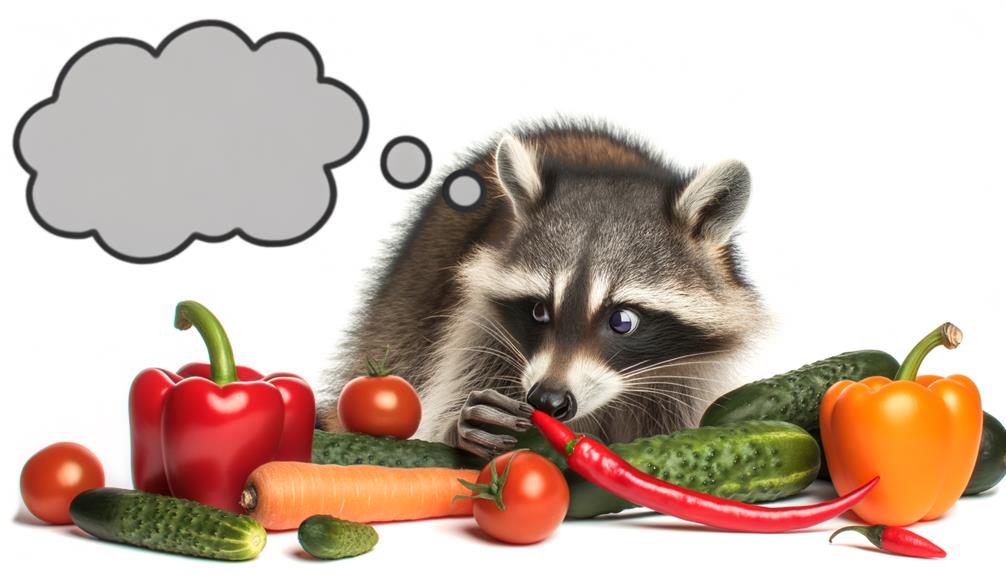
Raccoons possess taste receptors that can detect capsaicin, the active component in spicy foods, which may influence their sensitivity similar to that observed in other mammals.
The ingestion of capsaicin can have varied effects on their digestion, potentially causing gastrointestinal discomfort or alterations in gut motility.
Moreover, the natural dietary habits of raccoons, which primarily consist of fruits, insects, and small animals, suggest that spicy foods are not a typical component of their diet.
Raccoons' Taste Receptors
Research indicates that raccoons possess a lower density of capsaicin receptors, which are responsible for detecting the spicy compound in foods. This reduced receptor density implies that raccoons are less sensitive to capsaicin, potentially allowing them to tolerate spicier foods compared to humans.
The following points summarize key findings on raccoons' taste receptor sensitivity:
- Capsaicin Receptors: Raccoons have fewer capsaicin receptors (TRPV1) in their oral cavity, reducing their ability to detect spiciness.
- Behavioral Responses: Studies show raccoons exhibit less aversion to capsaicin-containing foods, implying lower sensitivity.
- Comparative Data: Comparative analysis with other mammals highlights that raccoons' tolerance to spicy foods is higher due to receptor density variations.
This evidence elucidates raccoons' unique gustatory profile concerning spicy foods.
Effects on Digestion
Given raccoons' decreased sensitivity to capsaicin, it is pertinent to explore how the consumption of spicy foods affects their digestive system. Capsaicin, the active component in spicy foods, can influence gastrointestinal processes differently in raccoons compared to humans. Scientific evidence suggests that while their taste receptors may not detect capsaicin strongly, its ingestion can still stimulate gastric acid secretion and affect gut motility.
| Parameter | Raccoons | Humans |
|---|---|---|
| Capsaicin Sensitivity | Decreased | High |
| Gastric Acid Secretion | Stimulated | Stimulated |
| Gut Motility | Altered | Altered |
These physiological responses can lead to potential digestive disturbances, including changes in bowel movements and stomach discomfort. Further research is essential to fully understand the long-term impacts on raccoons' digestive health.
Natural Dietary Habits
Despite their decreased sensitivity to capsaicin, the natural dietary habits of raccoons mainly consist of fruits, insects, and small vertebrates, indicating a preference for non-spicy foods. This omnivorous diet provides essential nutrients and energy, tailored to their ecological niche.
Evidence suggests that raccoons exhibit the following dietary preferences:
- Fruits: Including berries and other readily available plant materials, providing essential vitamins and fibers.
- Insects: Such as beetles and larvae, serving as protein sources vital for growth and development.
- Small Vertebrates: Including amphibians and rodents, contributing to their diverse nutrient intake.
Understanding these dietary habits underscores the raccoon's ecological adaptability and further suggests minimal evolutionary pressure to develop a tolerance for capsaicin-rich foods.
Health Implications
The ingestion of spicy foods by raccoons can lead to various health implications, primarily affecting their gastrointestinal system. Capsaicin, the active component in spicy foods, can cause mucosal irritation, inducing symptoms such as vomiting and diarrhea. Prolonged exposure may result in gastritis or even ulceration. The table below outlines potential health effects:
| Symptom | Clinical Implication |
|---|---|
| Vomiting | Gastrointestinal distress |
| Diarrhea | Dehydration, electrolyte imbalance |
| Gastritis/Ulcer | Chronic mucosal damage |
Additionally, the metabolic response to capsaicin can vary widely among individual raccoons, leading to unpredictable health outcomes. It is essential to consider these clinical manifestations when evaluating the suitability of spicy foods for raccoon diets. Understanding these implications can guide better wildlife management practices.
Behavioral Changes
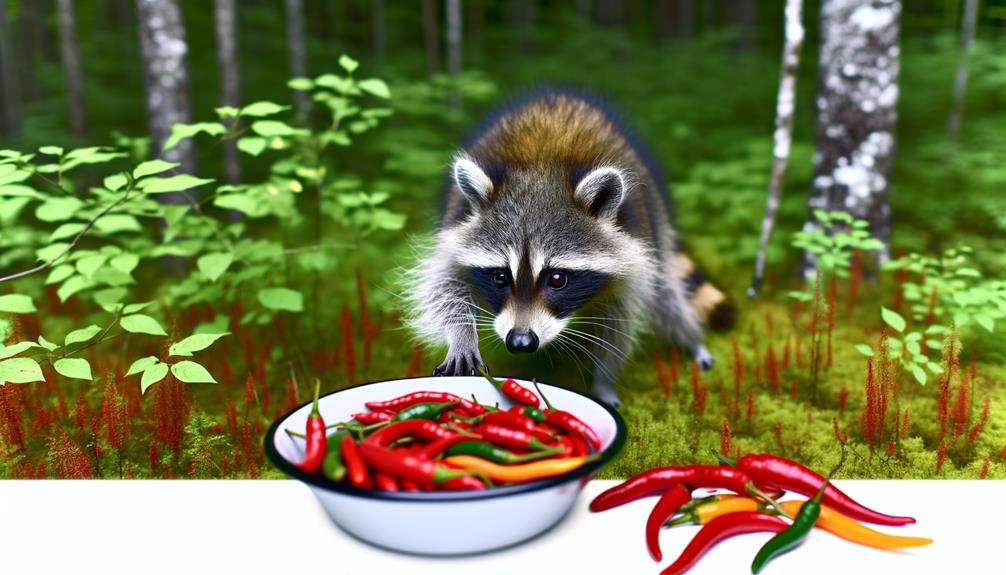
While the health implications of spicy food ingestion in raccoons are significant, it is also critical to examine the resultant behavioral changes that may arise from such dietary exposure. Observational studies indicate that raccoons may exhibit several alterations in their behavior post-ingestion of capsaicin-laden foods.
Key behavioral changes include:
- Increased Agitation: Raccoons may display heightened irritability and restlessness, likely due to discomfort and pain associated with capsaicin's effects on the gastrointestinal tract.
- Altered Foraging Patterns: Exposure to spicy foods can lead to changes in foraging behaviors, with raccoons potentially avoiding areas where such foods are prevalent.
- Social Interactions: There may be a noticeable shift in social dynamics, as affected raccoons could become more reclusive or aggressive towards conspecifics.
These behavioral shifts warrant further empirical investigation to understand their long-term implications.
Expert Opinions
According to leading wildlife ecologists and veterinarians, the ingestion of spicy foods by raccoons can result in both acute and chronic physiological stress. Capsaicin, the active component in chili peppers, has been documented to cause gastrointestinal irritation, inflammation, and discomfort in raccoons.
Clinical observations indicate that exposure to capsaicin can lead to symptoms such as vomiting, diarrhea, and abdominal pain. Chronic ingestion may disrupt nutrient absorption and compromise gut health. Additionally, capsaicin is known to affect the mucosal lining, potentially causing long-term damage to the esophagus and stomach.
These physiological responses underscore the importance of understanding the dietary limitations and natural feeding behaviors of raccoons, to prevent adverse health outcomes and ensure their well-being in both wild and urban environments.
Feeding Recommendations
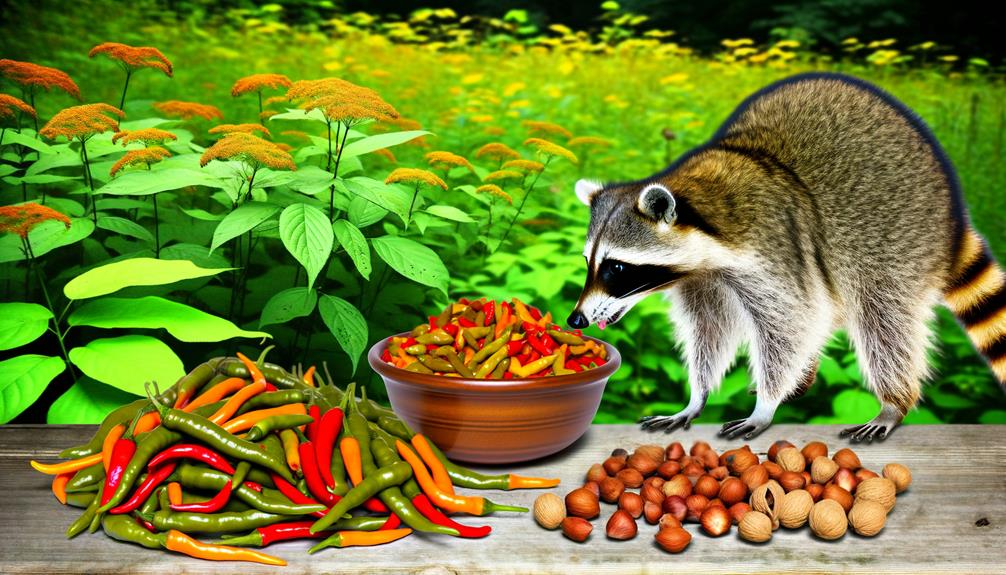
Given the potential health risks associated with spicy foods, it is crucial to provide raccoons with a diet that closely mirrors their natural foraging habits. Evidence suggests that raccoons thrive on a varied diet that ensures nutritional balance.
Clinical recommendations for feeding raccoons include:
- Fruits and Vegetables: High in fiber and essential vitamins, offering raccoons a balanced diet akin to their natural consumption.
- Protein Sources: Insects, small mammals, and fish provide necessary amino acids and are essential to their dietary needs.
- Nuts and Seeds: These offer healthy fats and proteins, contributing to overall energy requirements and bodily functions.
Providing these dietary components can mitigate health risks and support optimal physiological functioning in raccoons.
Conclusion
Raccoons' consumption of spicy foods, specifically capsaicin, reveals a complex interplay between their natural diet and physiological tolerances. Evidence indicates that while raccoons may exhibit curiosity, their sensitivity to capsaicin could lead to adverse health effects and behavioral changes.
Clinical observations and expert opinions underscore the importance of adhering to their natural dietary preferences to guarantee well-being. Consequently, introducing spicy foods to raccoons should be approached with caution, akin to finding a way through a maze of potential health risks.






